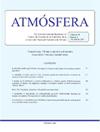Evaluation of the SACZ index as a prognostic tool based on GFS forecasts
IF 1
4区 地球科学
Q4 METEOROLOGY & ATMOSPHERIC SCIENCES
引用次数: 0
Abstract
The South Atlantic Convergence Zone (SACZ) is an atmospheric phenomenon typical of summertime where a band of nebulosity causes intense or persistent rainfall in many regions of Brazil. SACZ episodes can be responsible for many natural disasters. Besides, the impacts of rainfall on water availability and consequently on the energy sector are extensive. The main objective of this study was to investigate the implementation of the SACZ index as an objective forecasting tool using input data from the Global Forecast System (GFS) model. Initially, we compared the index with the SACZ events identified by the Center for Weather Forecasting and Climate Studies (CPTEC ) from 2017 to 2021. Results showed that the index represented all events identified SACZs by CPTEC. Finally, we used data from the GFS 0.25 Degree from 2017 to 2021 to calculate Accuracy, Probability of detection, and False alarm ratio to evaluate the SACZ index as a prediction tool. Three thresholds are defined for the binary classification of a possible SACZ event. Results showed that above the most sensitive threshold (h1), within 10 days in advance, the sign of a possible SACZ can be detected. For the intermediate threshold (h2), a forecast of 96 h can detect a sign. For the most specific threshold (h3), the index can detect the event within 72 h in advance with a probability of detection of almost 90%. The SACZ index proved to be an efficient tool for detecting the dynamics of the phenomenon and can be used to assist operationally and in decision-making.基于GFS预测的SACZ指数作为预测工具的评价
南大西洋辐合带(SACZ)是一种典型的夏季大气现象,在那里,一团云雾导致巴西许多地区出现强烈或持续降雨。SACZ事件可能导致许多自然灾害。此外,降雨对供水的影响是广泛的,因此对能源部门也有影响。本研究的主要目的是利用全球预测系统(GFS)模型的输入数据,调查SACZ指数作为客观预测工具的实施情况。首先,我们将该指数与2017年至2021年天气预报和气候研究中心(CPTEC)确定的SACZ事件进行了比较。结果表明,该指数代表了CPTEC鉴定出的sacz的所有事件。最后,我们使用2017 - 2021年GFS 0.25度的数据计算准确率、检测概率和虚警率,以评估SACZ指数作为预测工具的可行性。为可能的SACZ事件的二元分类定义了三个阈值。结果表明,在最敏感阈值(h1)以上,提前10天就可以检测到可能的SACZ迹象。对于中间阈值(h2), 96小时的预测可以检测到信号。对于最具体的阈值(h3),该指数可以提前72 h内检测到事件,检测概率几乎为90%。事实证明,SACZ指数是一种有效的工具,可用于探测这种现象的动态,并可用于协助业务和决策。
本文章由计算机程序翻译,如有差异,请以英文原文为准。
求助全文
约1分钟内获得全文
求助全文
来源期刊

Atmosfera
地学-气象与大气科学
CiteScore
2.20
自引率
0.00%
发文量
46
审稿时长
6 months
期刊介绍:
ATMÓSFERA seeks contributions on theoretical, basic, empirical and applied research in all the areas of atmospheric sciences, with emphasis on meteorology, climatology, aeronomy, physics, chemistry, and aerobiology. Interdisciplinary contributions are also accepted; especially those related with oceanography, hydrology, climate variability and change, ecology, forestry, glaciology, agriculture, environmental pollution, and other topics related to economy and society as they are affected by atmospheric hazards.
 求助内容:
求助内容: 应助结果提醒方式:
应助结果提醒方式:


